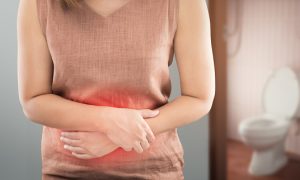
Osmotic diarrhea is thought to occur when food is not fully absorbed in the small intestine, exerting an osmotic force which draws an excessive amount of fluid into the intestine. Osmotic diarrhea can occur in any way and is especially prone in individuals intolerant to sugar and those suffering from malabsorption syndrome.
What causes osmotic diarrhea?
The absorption of water in the digestive tract is highly dependent on the adequate absorption of solutes, the components of the food you eat. If your food simply remains in the gut and is not absorbed, water will not be absorbed either and diarrhea will likely result. Additionally, more water may be drawn away from the body into the digestive tract as well, further contributing to osmotic diarrhea.
Osmotic diarrhea typically results from one of the two situations:
- Ingestion of poorly absorbed substrate: The may be due to carbohydrate molecules or divalent ions. Common offending agents include the ingestion of sweeteners such as mannitol or sorbitol, also Epsom salts and some antacids
- Malabsorption: Due to the inability to absorb carbohydrates and is one of the most common causes for the development of diarrhea. Common examples include lactose intolerance, celiac disease, and chronic pancreatitis.
Other osmotic diarrhea causes include:
- Fat malabsorption
- Dumping syndrome
- Poor digestion
- Certain drugs, such as antibiotics and blood pressure medication.
- Taking laxatives that contain sodium phosphate, magnesium sulfate, magnesium phosphate.
- Undergoing chemotherapy or high dose radiation therapy.
- Surgical removal of the gallbladder
Osmotic diarrhea symptoms
Aside from the increased frequency and watery consistency of stool that is characteristic of osmotic diarrhea, additional symptoms may also be present. Symptoms can develop within a few hours after eating or drinking the particular trigger and often makes those affected feel exhausted and tired due to the excessive loss of water.
Osmotic diarrhea symptoms include:
- Abdominal pain before the passage of stool
- Forceful bowel evacuation
- Cramping and/or bloating
- Nausea
Severe symptoms of osmotic diarrhea may include:
- Tarry stools
- High fever
- Pus or blood in stool
- Dry skin or lips
Treatment for osmotic diarrhea
Mild cases of osmotic diarrhea can be cured without the use of any medication. Once the cause of diarrhea has been cleared from the body, as in the case of certain types of foods, the condition typically begins to resolve on its own. However, as is the case with most chronic diarrhea conditions, the replacement of fluids is very important, as it is lost in excess. If dehydration is allowed to persist, it may lead to electrolyte imbalances, which can lead to further complications in children and the elderly.
Severe cases of osmotic diarrhea should be assessed by a physician as they will be able to recognize the subtle signs of electrolyte imbalance and ensure appropriate treatment is implemented right away.
Generally speaking, stopping the foods causing your case of osmotic diarrhea is advised, along with getting plenty of rest and taking an over-the-counter painkiller if needed. The BRAT diet, consisting of bananas, rice, applesauce, and toast is also a good way for reducing the frequency of stools.
Osmotic diarrhea prevention
Depending on the underlying cause, prevention of your osmotic diarrhea may be different. However, the following recommendations for diarrhea prevention can be a good rule of thumb:
- Food safety: Abstain from eating food that is cold, raw, and stale while traveling or eating out. Food can become contaminated with germs at many stages during food processing. It is recommended to consume food that had been boiling hot or food that has been cooked in front of you to better know your food hasn’t been contaminated.
- Water: It is always better to use filtered and boiled water to prevent diarrhea. Water is most susceptible to bacterial and viral contamination.
- Eat food rich in fiber: Helps to maintain and enhance digestive health. Fiber-rich foods that help to treat or prevent diarrhea include whole grain cereals and millets, pulses, vegetables, and fruits with their skin and seeds.
- Gluten and lactose allergy: If you are sensitive to these products, it is highly recommended to avoid them and consume their respective alternatives.
- Visit your doctor: If you are experiencing diarrhea for more than two to three days and you are concerned it will not resolve on its own, see your doctor to find the cause and treatment.
Diet and home remedies for osmotic diarrhea
Diarrhea is a condition that can most often be taken care at home, but some cases require the aid of an experienced medical professional. However, for the most part, your body will take care of itself until your bowel symptoms have resolved. The following are some of the most commonly used home remedies for osmotic diarrhea:
- Drink electrolyte-rich fluid: This may be ginger ale, coconut water, or even Gatorade. All of these fluids contain essential electrolytes such as sodium, potassium, and glucose, which your body needs and is lost during excessive cases of watery diarrhea.
- Eat probiotic foods: This includes eating plenty of fermented foods, including live-culture yogurt, fermented salsa, kimchi, and naturally fermented pickles. Your gut is full of beneficial bacteria that may become killed off with the use of various types of antibiotics. Consuming probiotic foods is a great way to counteract this and replenish healthy bacterial colonies.
- Chew your food: Large undigested food particles in the intestinal tract can lead to bloating, diarrhea, constipation, abdominal pain, and other digestive problems.
Foods recommended for diarrhea sufferers include:
- Bananas
- Applesauce
- Beets
- Cabbage
- Carrots
- Citrus fruits
- Dried peas
- Okra
- Boiled potatoes
- Cooked chicken
- Psyllium Husk
- Plain white rice or toast
Related: Diarrhea causes, symptoms, treatment, and natural remedies